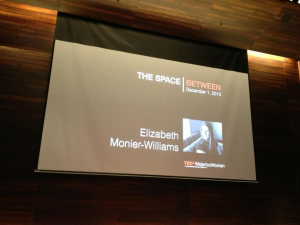Talking Twitter with Elizabeth Monier-Williams
We’re honored to welcome Elizabeth Monier-Williams, AKA @Analyticeye to SocialNorth. Elizabeth writes The Analytic Eye, a blog about communications, marketing analysis, social media and digital culture. She’s also a Tedx speaker and the Marketing and Communications Manager for Mars Innovation. This is her story…
SocialNorth welcome submissions from everyone. Whether you’re focused on content, SEO, social media strategy or traditional PR, we’d love to hear from you. Visit our Writer’s Guidelines and share your expertise with our community.
Business basics for twitter – personal, professional & start-ups
If you’d told me in 2010 that Twitter would become a personal and professional tool that I use daily no matter where I am or what I’m doing, I would have been skeptical.
Three years in, I’m still amazed at how ubiquitous Twitter has become in my day-to-day life. (As I write this, I’m looking out the window of a BC ferry with Twitter chattering away in the background.)
Twitter provides my knowledge stream for what’s going on in the world, what’s trending in my profession, how the brands I work with are evolving and what people from all walks of life are thinking.
Combined with a web pingback, Twitter also played an instrumental role in getting one of my blog posts published in Scott Stratten’s The Book of Business Awesome. If you want the backstory, I’ve written about it in detail on my blog, The Analytic Eye.
I currently manage three Twitter accounts. I know a lot of people wear many hats here, so I’m going to talk about how I use Twitter for different roles.
Crucial Ground Rule: Don’t Cross Your Streams
 Although the Red Cross handled the “gettin’ slizzard” incident beautifully, tweeting personal content from a corporate account doesn’t always end well.
Although the Red Cross handled the “gettin’ slizzard” incident beautifully, tweeting personal content from a corporate account doesn’t always end well.
Do yourself a solid and avoid the temptation. Create procedures so you can’t cross professional and personal tweet streams. I have separate mobile apps for my personal and work accounts on my phone. I use Tweetdeck for my corporate accounts, but I don’t use it to tweet content from my personal account.
It’s very human to be excited about what you’re reading and forget which account you’re using.
I love using Twitter to talk to friends, colleagues and acquaintances, some of whom I know offline and most of whom I don’t.
Twitter advice for personal accounts
- Use a photo. And know that if you’re wearing a distinctive accessory, people may not recognize you without it when they meet you in person.
- Find thought leaders in your sector, both locally and internationally. Find ways to engage with them, particularly if you’re just starting out in your career. You never know where Twitter will take you.
- Share content, but avoid the temptation to retweet without reading. Headlines can be very misleading; content is sometimes lame.
- Research ahead of time. If you’re heading to a conference, read up on the event, speakers and other attendees beforehand. When you meet people in person, the ice will be broken.
- Follow a live event on Twitter and see how being plugged into the stream changes the way you experience a sport, breaking news or a television show.
- Be careful about linking your personal and professional lives. I don’t use the “my views are my own” statement in my Twitter bio—to me, it’s self-evident. I also don’t often use my account as a place to shill for work. I share content only when I think it’s fascinating and in line with my audience.
Twitter advice for corporate accounts
 I manage @MaRSInnovation, the Twitter account for MaRS Innovation (MI), an early-stage technology commercialization agent for start-ups and licensable tech emerging from Toronto’s leading research minds.
I manage @MaRSInnovation, the Twitter account for MaRS Innovation (MI), an early-stage technology commercialization agent for start-ups and licensable tech emerging from Toronto’s leading research minds.
It’s a bit like Dragon’s Den but with more science and fewer cameras. Here are a few things I do differently on Twitter for corporate accounts:
- Be clear about who’s tweeting. It helps to put a human face on your activity while making it obvious whom to contact if someone has a question or concern.
- Find content partners and mine their streams for complementary sector news, particularly if you’re getting started. MI is lucky to be affiliated with four universities, nine teaching hospitals, two research institutes and @MaRSDD (we’re separate organizations, though the names are similar).
- Develop lists and use them aggressively. MI has over 25 start-ups, 16 member institutions (each with divisions and departments) and many inventors, founders and staff who use Twitter. I use lists to keep track of conversations while making sure I don’t miss anything important. Some of my lists are public; some aren’t.
- Seek out new audiences. Are you interested in making international connections? Many consulates and embassies are on Twitter and eager to share news related to their home countries. They can also facilitate city visits.
- Set limits on your time. Although I check in with Twitter each day for work, I don’t live there. Make sure you start something you can maintain.
Twitter advice for start-ups
I consult with MI’s start-up companies, particularly when they’re at the stage when they can’t afford their own marketing or communications staff.
Twitter is a bit different for startups. Here are some guidelines:
- Register your start-up’s social handles, even if you’re miles away from needing them. Why pay for a name if you don’t have to? No start-up wants to incur unnecessary costs but when deciding on a name, the availability of URLs and social handles should be part of your decision-making process.
- Create separate identities for your team and company. Your founder might run the company Twitter account, but it shouldn’t be her or his Twitter account. Social handles are too important to be tied to any one person.
- Be stealthy, but transparent about what you’re doing. If you’re not ready to tweet, that’s fine, but tweet at least once to say you’re working toward a launch and invite people to follow for updates.
- You can’t invent a hashtag without an audience. Join existing conversations when you’re starting out. When you’ve got more of an audience, customize your conversations with your customers and/or community.
- It’s more than selling. Your company is more than your product and Twitter is a conversation. What can you contribute to industry-wide discussions? Do you have wisdom to share with other teams?
Do you have a social media story to share? We’d love to hear it – on our blog or on social media, of course. Follow us on Facebook, Twitter or LinkedIn and let’s continue the conversation.
About Elizabeth Monier-Williams
 Elizabeth Monier-Williams has over a decade of communications experience. She currently manages marketing and communications for MaRS Innovation and its related spin-off companies in Toronto, Canada. Her interests include start-up marketing, communications strategy, blogging and social media, cultural analysis, privacy online, the ways technology is changing higher education, and the evolving relationship between women, men and work.
Elizabeth Monier-Williams has over a decade of communications experience. She currently manages marketing and communications for MaRS Innovation and its related spin-off companies in Toronto, Canada. Her interests include start-up marketing, communications strategy, blogging and social media, cultural analysis, privacy online, the ways technology is changing higher education, and the evolving relationship between women, men and work.
In 2010, she founded The Analytic Eye, a blog about communications, social media and marketing analysis. Two years later, her blog post, “5 Viral Takeaways from Nightmares Fear Factory” was republished as a chapter in The Book of Business Awesome.
Elizabeth delivered a talk at TedxWaterlooWomen in December 2012 about why women seeking balance in their working lives need better female superhero stories (video forthcoming). Catch up with Elizabeth online:


I think I have the wear a distinctive accessory tip in your twitter photo on lockdown 🙂
Great insight. I particularly like the suggestion to follow a live event with a twitter stream. I think for those getting started, that helps get a feel for twitter.
You guys are definitely the queens of the tiaras.